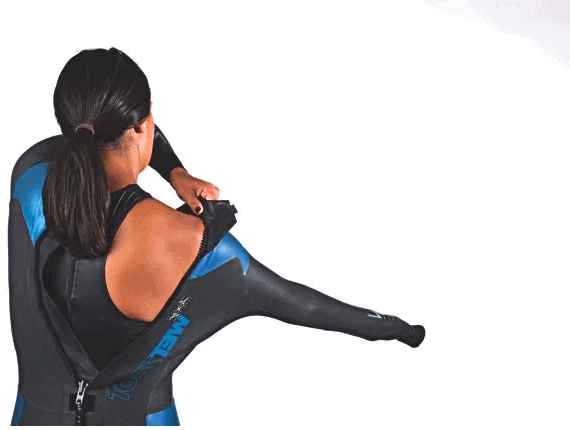How to Properly Wear a Wetsuit
Wearing a wetsuit can be an extreme sport on its own. You want the wetsuit to fit you perfectly and also be comfortable enough to move around while in water. Having the right tips and hacks will help you properly wear your wetsuit without breaking a sweat.
To properly wear a wetsuit, you need to ensure that it fits perfectly but is not too tight that it restricts blood flow or body movement.
Below are some of the tips and hacks to help you put on a wetsuit effortlessly whether it’s your 1st or 100th time.
Step 1
Picking the right wetsuit and protective gear
If you already own a wetsuit then this should be easy you can skip right to step 2.
Picking a wetsuit at a rental shop can be quite tricky. You want to find one that fits and hugs your body perfectly, nothing baggy or very tight. The most important thing when walking into a rental shop is knowing your size. If you are not sure you can always ask the owner to assist you in picking one.
Always inspect the wetsuit before leaving, check for any tears or sticky zips, and swap before renting it out.
Once you have the perfect suit, it’s time to put it on. While some people have no problem wearing the wetsuits only others like to wear a protective garment underneath such as a rash guard or simply wear a swimsuit.

Step 2
Unzip the wetsuit
This helps you wear and pull the wetsuit up.
Some wetsuits don’t have any zippers, I once dived in such and I must say emotions were running high when putting it on :-). I was frustrated, angry, and sad all at the same time but I did manage to get it on.
Many divers prefer wetsuits with zippers; they are easy to work with. Turning the suit inside out can ease the wearing process.
The zipper always goes to the back NEVER in front!
Step 3
Start with the feet
Start by putting on one foot and pulling the wetsuit fabric up to the knee, then repeat the same process on the other foot. Ensure that the fabric hugs the skin perfectly and that no folds or wrinkles are left behind.
Once both feet are in the wetsuit, now pull each side up to the mid-thigh ensuring the fabric lines smoothly onto your skin. Repeat this on the other leg and remember to handle the wetsuit carefully to avoid ripping or tearing it.
Simple Hacks
- If you experience trouble getting the feet into the wetsuit use a plastic bag or socks. Simply wear the plastic bag like you would wear a sock, then slip your foot into the wetsuit. It slides in smoothly.
- Applying oil to the feet or thighs will help pull the wetsuit up smoothly without leaving any folds or wrinkles.
- Always smoothen the wetsuit as you move up
Step 4
Pull the wetsuit over the hips and torso
This part should be done right for easy movement and comfort. Pull the wetsuit over the hips until the crotch of the suit snugs well onto your crotch.
Pull the wetsuit on the back as well it shouldn’t be loose near the buttocks. Adjust it accordingly and ensure nothing is squeezed or pinched around the crotch area.
Once the wetsuit is at the waist it’s easy to pull it up the torso.
Pull the suit all the way up to your chest.
Step 5
One arm at a time
Use gloves, a plastic bag, or a sock to pull the suit up the arm to the shoulder. Repeat with the other arm.
If all parts were done right, the wetsuit should now fall into place ready to be zipped up. However, you may notice that the suit doesn’t cover your neck.
This means the wetsuit is too small for you or you didn’t pull the wetsuit fabric around your crotch area.
Step 6
Smoothen everything up
Examine the suit from the feet up, if you still have a lot of folds or the suit isn’t fitted around the crotch area you’ll need to pull it up.
If there is no fabric available, this means the suit is too small, pick a new one and repeat the process.
In this step, start at the hip area and pull any available fabric up.
You can also try bending to the front and pick any folds that are available around the stomach or waist area. Pick them and pull gently up the torso.
Next, bend to the sides and check for any folds. Pull these all the way up to the armpits on each side.
Now move the arms around and check if it’s easy and comfortable to move in.
Step 7
Zip and Seal
Once everything is perfect and in a comfortable position. Pull the zipper up or ask a friend to help you zip up.
Secure the zipper and fasten the velcro fastening around the neck area. This ensures the wetsuit fits around the neck waterproofing it.
Step 8
Enjoy your Dive!
How to remove a wetsuit
This would be the reverse of putting on a wetsuit
Start by loosening the velcro fastening around the neck
Unzip the wetsuit then take it off one arm first then the other.
Followed by the feet
Ways to ensure the wetsuit comes off easily is by:
- Applying oil to the arms, thighs, and legs. This helps the wetsuit slide out effortlessly and should be done when putting the wetsuit on.
- Another hack is by allowing water in the wetsuit through the neck area when it’s time to exit the water. This will ease up the removal process.
Removing a sweaty or sticky wetsuit is as difficult as trying to put on a dry wetsuit onto a wet body.
Do You Wear Anything under a Wetsuit
The answer to this question differs based on who you ask.
Some divers have no problem wearing only a wetsuit while others may be embarrassed when it’s time to change and prefer to wear a swimsuit or a rash guard underneath.
There is absolutely no problem or shame in how you choose to wear the wetsuit as long as you are comfortable in your own skin and those around you have no problem with it.
Divers who own diving gear can choose to wear something underneath or simply wear the wetsuit only.
When renting wetsuits, it’s better to have something underneath them for hygiene reasons. The suits are worn by different people and since you are not certain of how they are cleaned better be safe than sorry.
In addition, wetsuits can get a bit rough if not cared for properly and could easily irritate the skin. A rash guard will save you a lot of wetsuit-related issues such as scratching or allergic reactions.
Wearing something underneath is also a sign of common courtesy. Some people have no problem changing while others may be uncomfortable with nudity or there could be young children around. At least wear a swimsuit to avoid embarrassment and uncomfortable situations.
What to Wear Under Wetsuit for Females
Most ladies wear a regular swimsuit underneath the wetsuit or a rash guard.
Ensure that the garment worn underneath the wetsuit is light and thin for comfort. It also prevents folding or formation of wrinkles on the suit as you pull it up.
The rash guard should blend in smoothly and shouldn’t interfere with wearing the wetsuit.

What to Wear Under Wetsuit for Males
Rash guards for men work perfectly, other male divers prefer to only wear swimming shorts.
The same case applies to men, anything worn under the wetsuit should be light and comfortable and shouldn’t impair movement or wearing the wetsuit.
Always ensure the swim short isn’t too big as they will cause you some problems when wearing the wetsuit.
Do You Put On a Wetsuit Wet or Dry
Either way works just fine depending on individual preference.
If you find it easy wearing a wetsuit dry, then you should also be dry.
If you prefer wearing a wetsuit wet, then you should first wet your body before trying to get into it.
Wearing a dry wetsuit when your body is wet will be an extreme sport for you. The body sticks all over the wetsuit making it very difficult to slide your fit or arms through it.
If you’ve ever tried getting dressed in a hurry before completely drying your body you know how hard it is to put on clothes. This is the same experience when trying to put on a dry wetsuit when your body is wet.
How Tight Should a WetSuit Fit
A wetsuit should fit snugly onto your body not too loose and not too tight.
If it feels like someone is pinching you when wearing a wetsuit, then it’s too tight and most likely not your size.
If you can easily get into a wetsuit like you would when putting on baggy trousers, then it’s too big for you.
A good wetsuit should hug your skin perfectly and should be easy to move around in.
Tight wetsuits can restrict blood flow causing serious health problems.
Baggy wetsuits will allow a lot of water risking hypothermia since the body can’t keep this water warm as it flows through the wetsuit.





